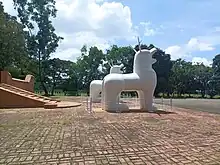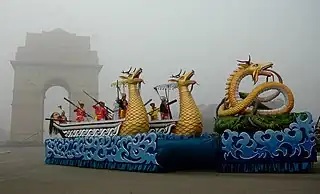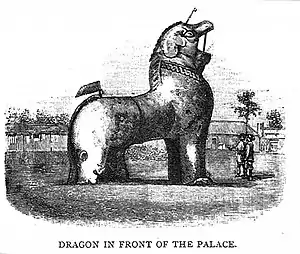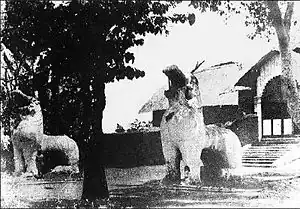Kanglā Shā
In Meitei mythology and religion, Kangla Sa (Meitei for 'Beast of the Kangla'), also spelled as Kangla Sha, is a guardian dragon lion. It has a lion's body and a dragon's head, with two horns. It is considered sacred to the Meitei heritage.[1][2] It is a royal symbol of the Meitei royalties (Ningthouja dynasty).[3] The most remarkable statues dedicated to "Kangla Sa" stand inside the Kangla.[4]
| Kangla Sa (Kangla Sha)[lower-alpha 1] | |
|---|---|
God of defense, guardianship and protection | |
| Member of Meitei dragons | |
 Northern view of the Statues of Kanglasha, the Meitei mythical Dragon Lion God, after the removal of rods between jaws, located inside the Kangla Fort in Imphal, Manipur | |
| Other names | Kanglasha Kanglaa Shaa Kanglasa Kanglaa Saa |
| Affiliation | Meitei mythology (Manipuri mythology) Meitei folklore (Manipuri folklore) Meitei religion (Sanamahism) |
| Major cult center | Kangla |
| Abode | Kangla |
| Region | Ancient Kangleipak (early Manipur) |
| Ethnic group | Meitei ethnicity |
| Term | |
|---|---|
| English | Kangla Sa |
| Ancient Meitei | ꯀꯪꯂꯥ ꯁꯥ (ꯀꯪꯂꯥꯁꯥ) (kəŋ.lā sā (kəŋ.lā.sā)) |
| Modern Meitei | ꯀꯡꯂꯥ ꯁꯥ (ꯀꯡꯂꯥꯁꯥ) (kəŋ.lā sā (kəŋ.lā.sā)) |
| Sanamahism | |
| Part of a series on |
| Meitei mythology |
|---|
 |
|
|
In Meitei traditional race competitions, winners of the race are declared only after symbolically touching the statue of the dragon "Kangla Sha".[5]
Etymology
_in_different_spellings.jpg.webp)
In Meitei language (officially called Manipuri language), the name "Kangla Sha" (originally spelled as "Kangla Sa") is made up of two independent words "Kangla" (Meitei: ꯀꯪꯂꯥ / ꯀꯡꯂꯥ) and "Sa" (Meitei: ꯁꯥ). The Meitei term "kanglā" (Meitei: ꯀꯪꯂꯥ / ꯀꯡꯂꯥ, lit. 'Kangla') is the name of an important historical place in Imphal, Manipur.[6][7] The Meitei language term "sā" (Meitei: ꯁꯥ) has multiple meanings based on different parts of speech. As a noun, "sā" (Meitei: ꯁꯥ) may mean: (1) body, (2) animal or (3) flesh or meat. As a verb, "sā" (Meitei: ꯁꯥ) may mean (1) making, building, preparing, or (2) playing a role, or (3) dancing. As an adjective, "sā" (Meitei: ꯁꯥ) may mean "hot".[8][9]
History

In the year 1804, Meitei king Chourjit Singh (Meitei: ꯅꯤꯡꯊꯧ ꯆꯧꯔꯖꯤꯠ ꯁꯤꯡꯍ)(1803-1813 AD) constructed two huge structures of the "Kangla Sha" dragon lions in front of the Kangla Uttra Shanglen (or simply called the "Uttra") inside the present day Kangla Fort. These two statues were demolished by the Burmese forces during the Chahi Taret Khuntakpa (Meitei for 'Seven Years Devastation') (1819-1826).[10][11][12][13]

During the months of June and July in the year 1844, Meitei king Raja Nara Singh (Meitei: ꯅꯤꯡꯊꯧ ꯅꯔꯁꯤꯡꯍ) reconstructed the two statues of the Kangla Sha dragons once again.[14][15][16][17][18]
During the British conquest of the Anglo Manipur War of 1891, the British forces led by Captain Allen demolished the two statues of the Kangla Sha dragons by blasting them by artillery fire into pieces on 20 July 1891.[19][20][21][22][23]
Later, in the year 2006, the statues of the "Kangla Sa" ("Kangla Sha") were reconstructed by the Government of Manipur.[24][25] Each statue is 19.30 feet in height, 15.30 feet in length and 6 feet in breadth. The weight of each statue is 36.50 metric tonne. The statues of the Kangla-Sha were sculpted based on the photographs published in the books including "The Lost Kingdom" and "The Meitheis" written by Thomas Callan Hodson. 4 kinds of bricks, found in the ruins of the Old Palace at Canchipur, were used during the construction of the sculptures. It took the craftsmen and sculptors 2 years to complete the construction works.[26]

Before the construction of the real sculptures, to take the comments, feedbacks, opinions and suggestions of the people, Sculptor B Mohendro Sharma presented the prototypes of the Kangla-Sha, made of mud, displayed on the public.[27]
Filming of the bombardment
On 9 December 2008, after getting permission from the Kangla Fort Board for shooting a film on the history of Kangla, associated with the demolition of the Kangla Sha statues in front of Kangla Uttra Shanglen, the "Manipur Film Development Corporation" (MFDC) Ltd. demolished the prototypes of Kangla Sha with the powerful crackers on 9 December, between 2 PM and 4 PM inside the Kangla.[28][29][30]
Removal of rods between jaws
On 18 June 2021, the "Kaba Khanba" (Meitei: ꯀꯕꯥ ꯈꯟꯕ, romanized: ka-bā khan-ba, lit. 'rods between jaws'[31]) of the Kangla Sha statues were removed by the Government of Manipur, along with the performances of religious rites and rituals by Amaibas (Meitei for 'priests') and Amaibis (Meitei for 'priestesses'), due to the perception by the authorities concerned that the rods gave pains to Kangla Sha, resulting in the downfall and unhappiness of the people of Manipur.[32][33] It was done after a unanimous joint decision by the Kangla Board, the Sanamahi Temple Board, the Uttra Shanglen, women's organisations of the Ima Keithel (Meitei for 'Ima Market') and the general public of Manipur.[34]
The action of the removal of rods taken up by the Government of Manipur led by Nongthombam Biren Singh, the Chief Minister of Manipur, and Leishemba Sanajaoba, the Rajya Sabha Member of Parliament, was given positive reactions by the "Lamlai Mapari Thougal Lup" and the "All India Kangla Pakhangba Temple Development Society".[35]
However, this event of the removal of rods drew criticism by RK Nimai, a retired IAS officer,[36][37] as
“The removal of kabak of the two kanglashas at Kangla which was shown in the local TV channels indicates the utter lack of knowledge of the so-called experts even in Meitei tradition.”[38]
He wrote an article about its criticism in the Imphal Free Press.[39][40] As a result, many social associations and organisations burnt newspaper copies of the Imphal Free Press.[41]
In a neutral response to the criticism and its reactions, Ethno Heritage Council (HERICOUN) stated:
“The organisation (Imphal Free Press) is not an expert body on the issue at hand and as such it is not a party in the argument between the supporters and opposers of removing the support rods from the mouths of the twin Kanglasha.”[42]
In reaction to the criticism, there was a strong objection by the "International Sanamahism Students' Association" (ISSA).[43]
Other iconography
On 17 July 2021, two statues dedicated to the "Kangla Sha", made of bricks, were installed by the 109 BN CRPF under the care of the IGP of Manipur and Nagaland sectors at the main entrance gate to the 109 BN Mongsangei, Imphal West district, Manipur. It was done to pay respect for the Meitei cultural traditions of Manipur.[44] The two bifurcated horns in the heads of each statue, are derived from the Sangai (Meitei for 'brow-antlered deer' Cervus eldi eldi), the state animal of Manipur, unlike the East Asian and Southeast Asian leogryphs.[45]
Heraldry
The government of Manipur recognised the illustration of Meitei mythical animal "Kangla Sha" as the state emblem in the year 1980.[46]
.svg.png.webp)
Namesakes
A music band named "Kanglasha" was organised in Imphal in 2007. Its lead singer is Tukun Chongtham, its lead guitarist is Mantosh Thokchom, its bassist is Sen Thokchom, its keyboard player is Surjit Kshetri and its drum player is Chingkhei Nongthonbam.[47][48]
Notes
- In Meitei language, there is no difference between "sa" and "sha".
References
- Chakravarti, Sudeep (6 January 2022). The Eastern Gate: War and Peace in Nagaland, Manipur and India's Far East. Simon and Schuster. p. 254. ISBN 978-93-92099-26-7.
- Session, North East India History Association (1990). Proceedings of North East India History Association. Original from:the University of Michigan. The Association. pp. 133, 134.
- Bhattacharyya, Rituparna (29 July 2022). Northeast India Through the Ages: A Transdisciplinary Perspective on Prehistory, History, and Oral History. Taylor & Francis. p. 203. ISBN 978-1-000-62390-1.
- Singh, N. Joykumar (2002). Colonialism to Democracy: A History of Manipur, 1819-1972. Original from : the University of Michigan. Spectrum Publications. p. 7. ISBN 978-81-87502-44-9.
The construction of ' Kangla Sa ' (Lion like animal) at the front of the gate of Kangla was a great achievement of his beautification programme.
- Lipoński, Wojciech (2003). World sports encyclopedia. Internet Archive. St. Paul, MN : MBI. p. 338. ISBN 978-0-7603-1682-5.
- Sharma, H. Surmangol (2006). "Learners' Manipuri-English dictionary (Definition of "kanglā")". dsal.uchicago.edu. University of Chicago. Retrieved 3 October 2022.
- Rastogi, Priyanka (13 May 2019). Early Sunrise, Early Sunset: Tales of a Solo Woman Traveler Across North East and East India. Partridge Publishing. p. 104. ISBN 978-1-5437-0523-2.
- Sharma, H. Surmangol (2006). "Learners' Manipuri-English dictionary (Definition of "sā")". dsal.uchicago.edu. University of Chicago. Retrieved 3 October 2022.
- Rastogi, Priyanka (13 May 2019). Early Sunrise, Early Sunset: Tales of a Solo Woman Traveler Across North East and East India. Partridge Publishing. p. 104. ISBN 978-1-5437-0523-2.
- Mehrotra, Deepti Priya (8 July 2009). Burning Bright Irom Sharmila. Penguin UK. p. 196. ISBN 978-81-8475-153-6.
- Lisam, Khomdan Singh (2011). Encyclopaedia Of Manipur (3 Vol.). Gyan Publishing House. p. 582. ISBN 978-81-7835-864-2.
- Lisam, Khomdan Singh (2011). Encyclopaedia Of Manipur (3 Vol.). Gyan Publishing House. p. 579. ISBN 978-81-7835-864-2.
- "Rods between jaws of Kangla Sha was to support structure from future damages". e-pao.net. Retrieved 3 October 2022.
- Mehrotra, Deepti Priya (8 July 2009). Burning Bright Irom Sharmila. Penguin UK. p. 196. ISBN 978-81-8475-153-6.
- Anvīkshā. Jadavpur University. 2004. p. 237.
- Lisam, Khomdan Singh (2011). Encyclopaedia Of Manipur (3 Vol.). Gyan Publishing House. p. 582. ISBN 978-81-7835-864-2.
- Lisam, Khomdan Singh (2011). Encyclopaedia Of Manipur (3 Vol.). Gyan Publishing House. p. 580. ISBN 978-81-7835-864-2.
- "Rods between jaws of Kangla Sha was to support structure from future damages". e-pao.net. Retrieved 3 October 2022.
- Mehrotra, Deepti Priya (8 July 2009). Burning Bright Irom Sharmila. Penguin UK. p. 196. ISBN 978-81-8475-153-6.
- Lisam, Khomdan Singh (2011). Encyclopaedia Of Manipur (3 Vol.). Gyan Publishing House. p. 582. ISBN 978-81-7835-864-2.
- Lisam, Khomdan Singh (2011). Encyclopaedia Of Manipur (3 Vol.). Gyan Publishing House. p. 742. ISBN 978-81-7835-864-2.
- Lisam, Khomdan Singh (2011). Encyclopaedia Of Manipur (3 Vol.). Gyan Publishing House. p. 580. ISBN 978-81-7835-864-2.
- "Kanglasha model bombarded: 10th dec08 ~ E-Pao! Headlines". e-pao.net. Retrieved 3 October 2022.
- "Kanglasha model bombarded: 10th dec08 ~ E-Pao! Headlines". e-pao.net. Retrieved 3 October 2022.
- "Rods between jaws of Kangla Sha was to support structure from future damages". e-pao.net. Retrieved 3 October 2022.
- "Opinions sought on Kangla-Sha prototype ~ E-Pao! News About Manipur". www.e-pao.net. Retrieved 4 October 2022.
- "Opinions sought on Kangla-Sha prototype ~ E-Pao! News About Manipur". www.e-pao.net. Retrieved 4 October 2022.
- "Kanglasha replica 'blast' on reel - Corporation records event as part of a documentary on Kangla Fort". www.telegraphindia.com. Retrieved 4 October 2022.
- "Kanglasha model bombarded: 10th dec08 ~ E-Pao! Headlines". www.e-pao.net. Retrieved 4 October 2022.
- "Kangla-Sha: 09th dec08 ~ E-Pao! Headlines". e-pao.net. Retrieved 4 October 2022.
- Sharma, H. Surmangol (2006). "Learners' Manipuri-English dictionary (Definition of "kabā")". dsal.uchicago.edu. University of Chicago. Retrieved 3 October 2022.
- "Rods between jaws of Kangla Sha was to support structure from future damages". e-pao.net. Retrieved 3 October 2022.
- "Now, Kanglasha can close its mouth, speak, swallow! - The Frontier Manipur". 18 June 2021. Retrieved 4 October 2022.
- "Now, Kanglasha can close its mouth, speak, swallow! - The Frontier Manipur". 18 June 2021. Retrieved 4 October 2022.
- "Bodies hail removal of rods from Kanglasha: 20th jun21 ~ E-Pao! Headlines". e-pao.net. Retrieved 4 October 2022.
- "Pseudo Experts on the Forefront!". Imphal Free Press. Retrieved 4 October 2022.
- "Kanglasha freedom of speech and ideas By Free Thinker". e-pao.net. Retrieved 4 October 2022.
- "Pseudo Experts on the Forefront!". Imphal Free Press. Retrieved 4 October 2022.
- "HERICOUN calls for sane argument on Kanglasha issue: 05th jul21 ~ E-Pao! Headlines". e-pao.net. Retrieved 4 October 2022.
- "Pseudo Experts on the Forefront!". Imphal Free Press. Retrieved 4 October 2022.
- "HERICOUN calls for sane argument on Kanglasha issue: 05th jul21 ~ E-Pao! Headlines". e-pao.net. Retrieved 4 October 2022.
- "HERICOUN calls for sane argument on Kanglasha issue: 05th jul21 ~ E-Pao! Headlines". e-pao.net. Retrieved 4 October 2022.
- "Criticism of Sanamahi religion over Kanglasha denounced: 28th jun21 ~ E-Pao! Headlines". e-pao.net. Retrieved 4 October 2022.
- "Kangla Sha installed at 109 Bn CRPF in Mongsangei: 18th jul21 ~ E-Pao! Headlines". e-pao.net. Retrieved 4 October 2022.
- "109 BN CRPF installs Kangla Sha: 18th jul21 ~ E-Pao! Headlines". e-pao.net. Retrieved 4 October 2022.
- Yü, Dan Smyer; Dean, Karin (30 September 2021). Yunnan–Burma–Bengal Corridor Geographies: Protean Edging of Habitats and Empires. Taylor & Francis. p. 154. ISBN 978-1-000-45842-8.
- "Kanglasha: E-Pao YellOut". e-pao.net. Retrieved 3 October 2022.
- "Kanglasha Lyrics: E-Pao YellOut". e-pao.net. Retrieved 3 October 2022.
Further reading
- Samerendra, Chongtham (2007). Hiyang Hiren Kanglasa Amasung Kangla (in Manipuri). Internet Archive. Rajiv Gandhi Center For Culture, Manipur.
- Lokendra, N. (1 January 1998). The Unquiet Valley: Society, Economy, and Politics of Manipur (1891-1950). Mittal Publications. p. 29. ISBN 978-81-7099-696-5.
- Chakravarti, Sudeep (11 April 2016). Highway 39: Reportagen aus Indiens aufständischem Nordosten (in German). Unionsverlag. p. 396. ISBN 978-3-293-30882-4.
- Singh, Sarina (21 April 2016). India (in Italian). EDT srl. p. 1258. ISBN 978-88-592-3227-8.
External links
- Kangla Sha at Internet Archive
- Kangla Sha at E-pao.net

